International Marketing Strategy for Next: Market Analysis Report
VerifiedAdded on 2019/12/03
|10
|3410
|184
Report
AI Summary
This report provides an analysis of the international marketing strategies for Next, a British multinational clothing and home products retailer. The research begins with an examination of macro and micro factors impacting the retail market, followed by an evaluation of market potential, specifically focusing on opportunities in the American, Indian, and Brazilian markets. The report recommends Brazil and India as viable markets for expansion, providing justifications for these selections. Furthermore, it suggests and justifies market entry strategies, including franchising, joint ventures, and business alliances. The report concludes with recommendations for adapting Next's marketing mix to suit the cultural and consumer behavior of the Brazilian and Indian markets, considering factors such as product, price, promotion, and place.
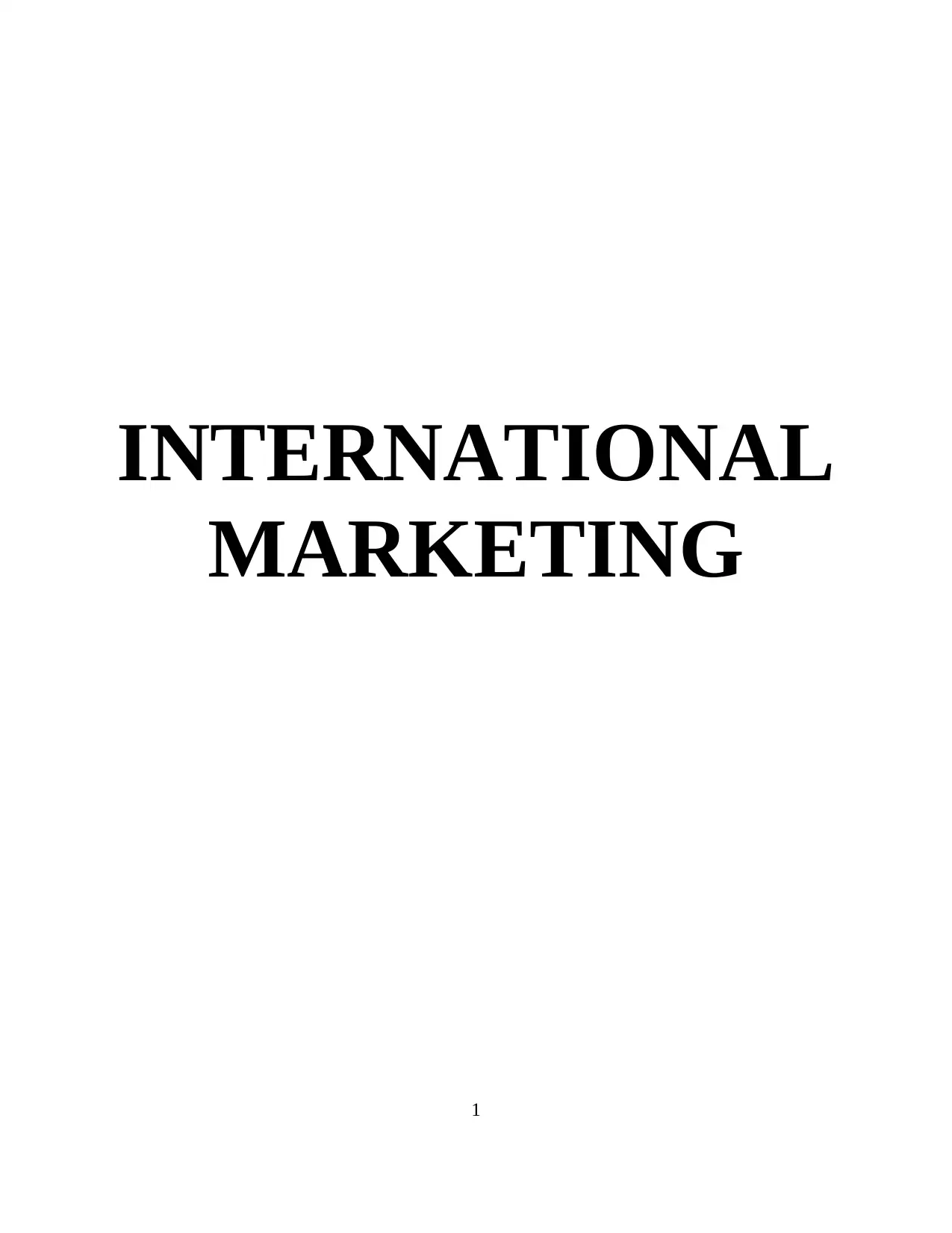
INTERNATIONAL
MARKETING
1
MARKETING
1
Paraphrase This Document
Need a fresh take? Get an instant paraphrase of this document with our AI Paraphraser
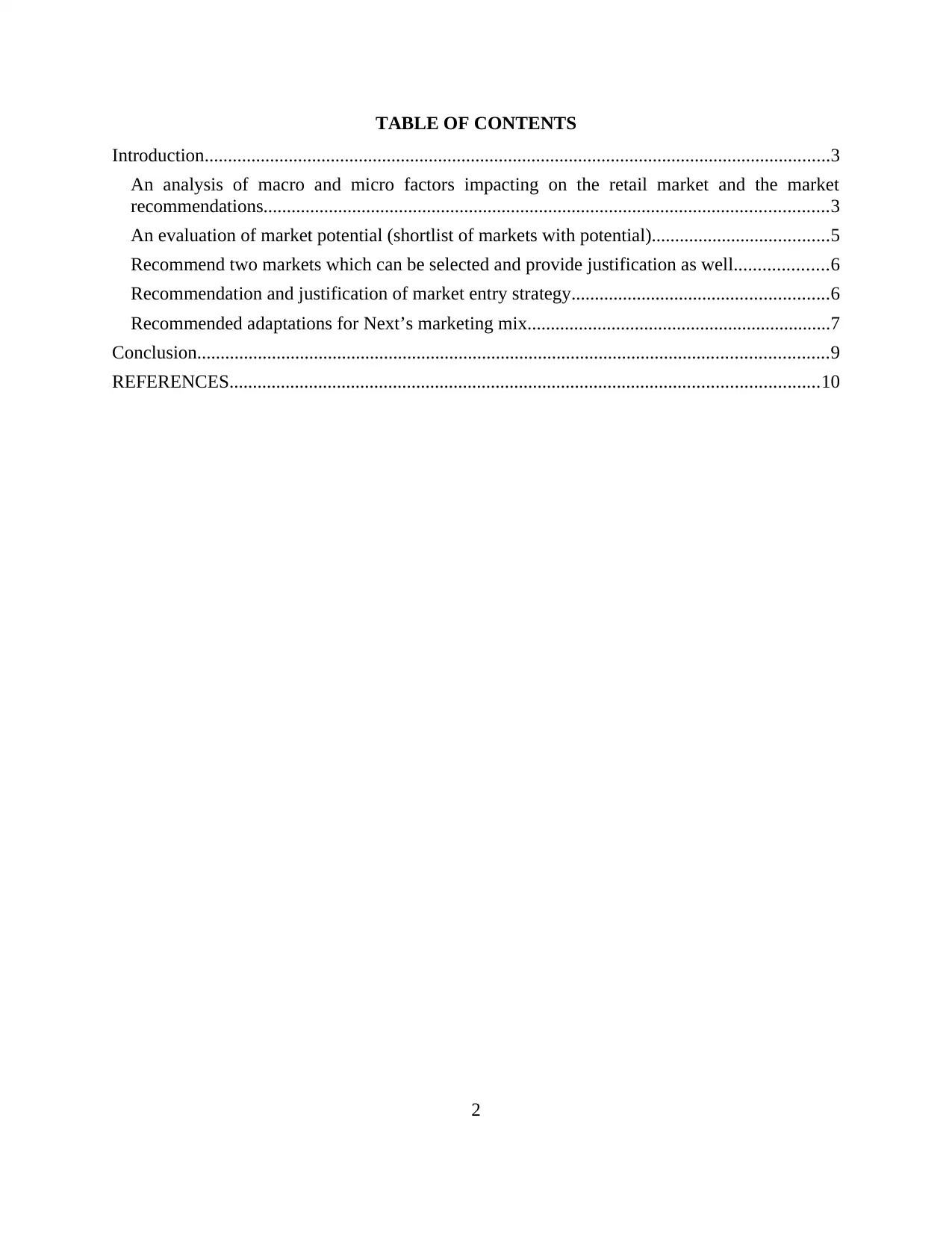
TABLE OF CONTENTS
Introduction......................................................................................................................................3
An analysis of macro and micro factors impacting on the retail market and the market
recommendations.........................................................................................................................3
An evaluation of market potential (shortlist of markets with potential)......................................5
Recommend two markets which can be selected and provide justification as well....................6
Recommendation and justification of market entry strategy.......................................................6
Recommended adaptations for Next’s marketing mix.................................................................7
Conclusion.......................................................................................................................................9
REFERENCES..............................................................................................................................10
2
Introduction......................................................................................................................................3
An analysis of macro and micro factors impacting on the retail market and the market
recommendations.........................................................................................................................3
An evaluation of market potential (shortlist of markets with potential)......................................5
Recommend two markets which can be selected and provide justification as well....................6
Recommendation and justification of market entry strategy.......................................................6
Recommended adaptations for Next’s marketing mix.................................................................7
Conclusion.......................................................................................................................................9
REFERENCES..............................................................................................................................10
2
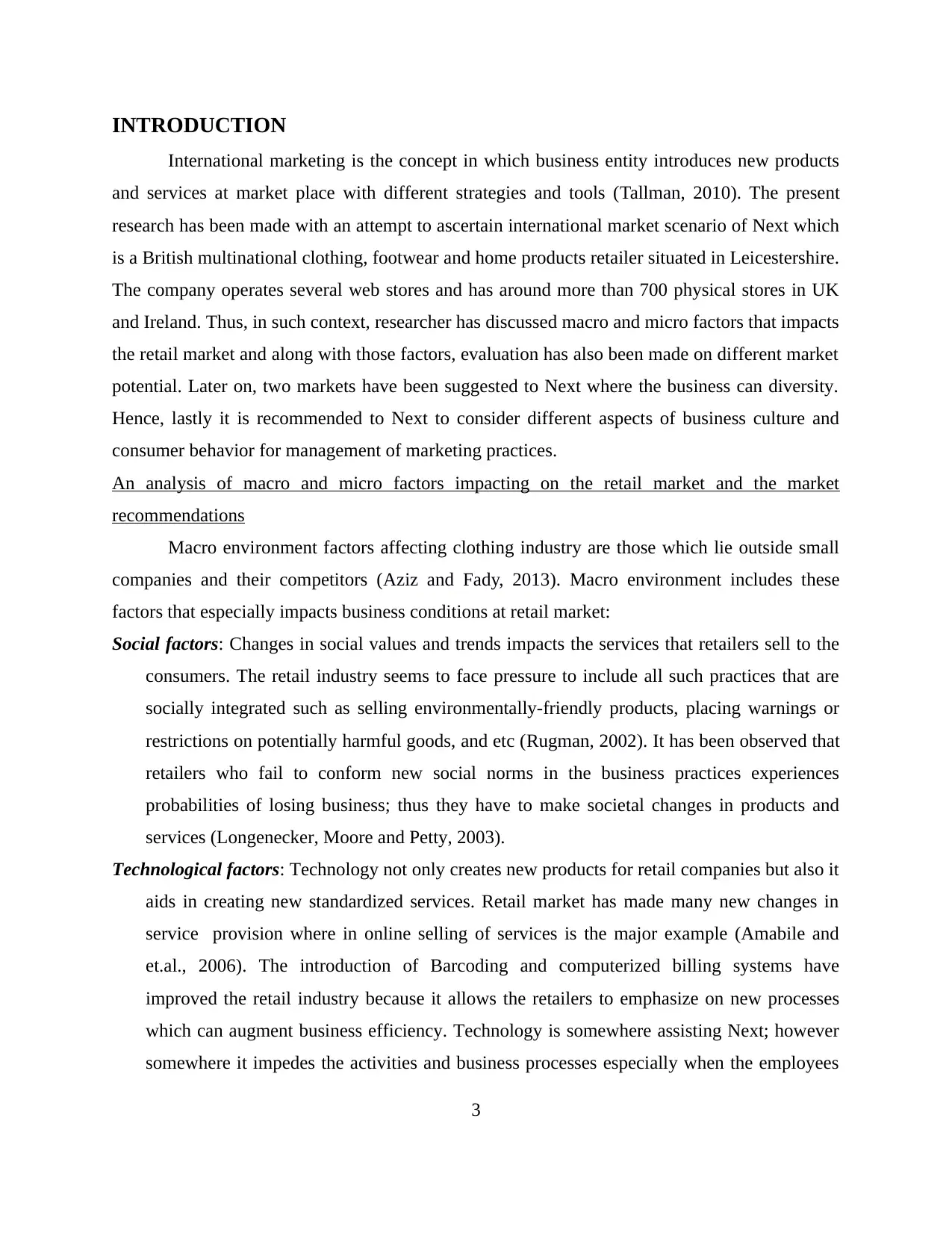
INTRODUCTION
International marketing is the concept in which business entity introduces new products
and services at market place with different strategies and tools (Tallman, 2010). The present
research has been made with an attempt to ascertain international market scenario of Next which
is a British multinational clothing, footwear and home products retailer situated in Leicestershire.
The company operates several web stores and has around more than 700 physical stores in UK
and Ireland. Thus, in such context, researcher has discussed macro and micro factors that impacts
the retail market and along with those factors, evaluation has also been made on different market
potential. Later on, two markets have been suggested to Next where the business can diversity.
Hence, lastly it is recommended to Next to consider different aspects of business culture and
consumer behavior for management of marketing practices.
An analysis of macro and micro factors impacting on the retail market and the market
recommendations
Macro environment factors affecting clothing industry are those which lie outside small
companies and their competitors (Aziz and Fady, 2013). Macro environment includes these
factors that especially impacts business conditions at retail market:
Social factors: Changes in social values and trends impacts the services that retailers sell to the
consumers. The retail industry seems to face pressure to include all such practices that are
socially integrated such as selling environmentally-friendly products, placing warnings or
restrictions on potentially harmful goods, and etc (Rugman, 2002). It has been observed that
retailers who fail to conform new social norms in the business practices experiences
probabilities of losing business; thus they have to make societal changes in products and
services (Longenecker, Moore and Petty, 2003).
Technological factors: Technology not only creates new products for retail companies but also it
aids in creating new standardized services. Retail market has made many new changes in
service provision where in online selling of services is the major example (Amabile and
et.al., 2006). The introduction of Barcoding and computerized billing systems have
improved the retail industry because it allows the retailers to emphasize on new processes
which can augment business efficiency. Technology is somewhere assisting Next; however
somewhere it impedes the activities and business processes especially when the employees
3
International marketing is the concept in which business entity introduces new products
and services at market place with different strategies and tools (Tallman, 2010). The present
research has been made with an attempt to ascertain international market scenario of Next which
is a British multinational clothing, footwear and home products retailer situated in Leicestershire.
The company operates several web stores and has around more than 700 physical stores in UK
and Ireland. Thus, in such context, researcher has discussed macro and micro factors that impacts
the retail market and along with those factors, evaluation has also been made on different market
potential. Later on, two markets have been suggested to Next where the business can diversity.
Hence, lastly it is recommended to Next to consider different aspects of business culture and
consumer behavior for management of marketing practices.
An analysis of macro and micro factors impacting on the retail market and the market
recommendations
Macro environment factors affecting clothing industry are those which lie outside small
companies and their competitors (Aziz and Fady, 2013). Macro environment includes these
factors that especially impacts business conditions at retail market:
Social factors: Changes in social values and trends impacts the services that retailers sell to the
consumers. The retail industry seems to face pressure to include all such practices that are
socially integrated such as selling environmentally-friendly products, placing warnings or
restrictions on potentially harmful goods, and etc (Rugman, 2002). It has been observed that
retailers who fail to conform new social norms in the business practices experiences
probabilities of losing business; thus they have to make societal changes in products and
services (Longenecker, Moore and Petty, 2003).
Technological factors: Technology not only creates new products for retail companies but also it
aids in creating new standardized services. Retail market has made many new changes in
service provision where in online selling of services is the major example (Amabile and
et.al., 2006). The introduction of Barcoding and computerized billing systems have
improved the retail industry because it allows the retailers to emphasize on new processes
which can augment business efficiency. Technology is somewhere assisting Next; however
somewhere it impedes the activities and business processes especially when the employees
3
⊘ This is a preview!⊘
Do you want full access?
Subscribe today to unlock all pages.

Trusted by 1+ million students worldwide
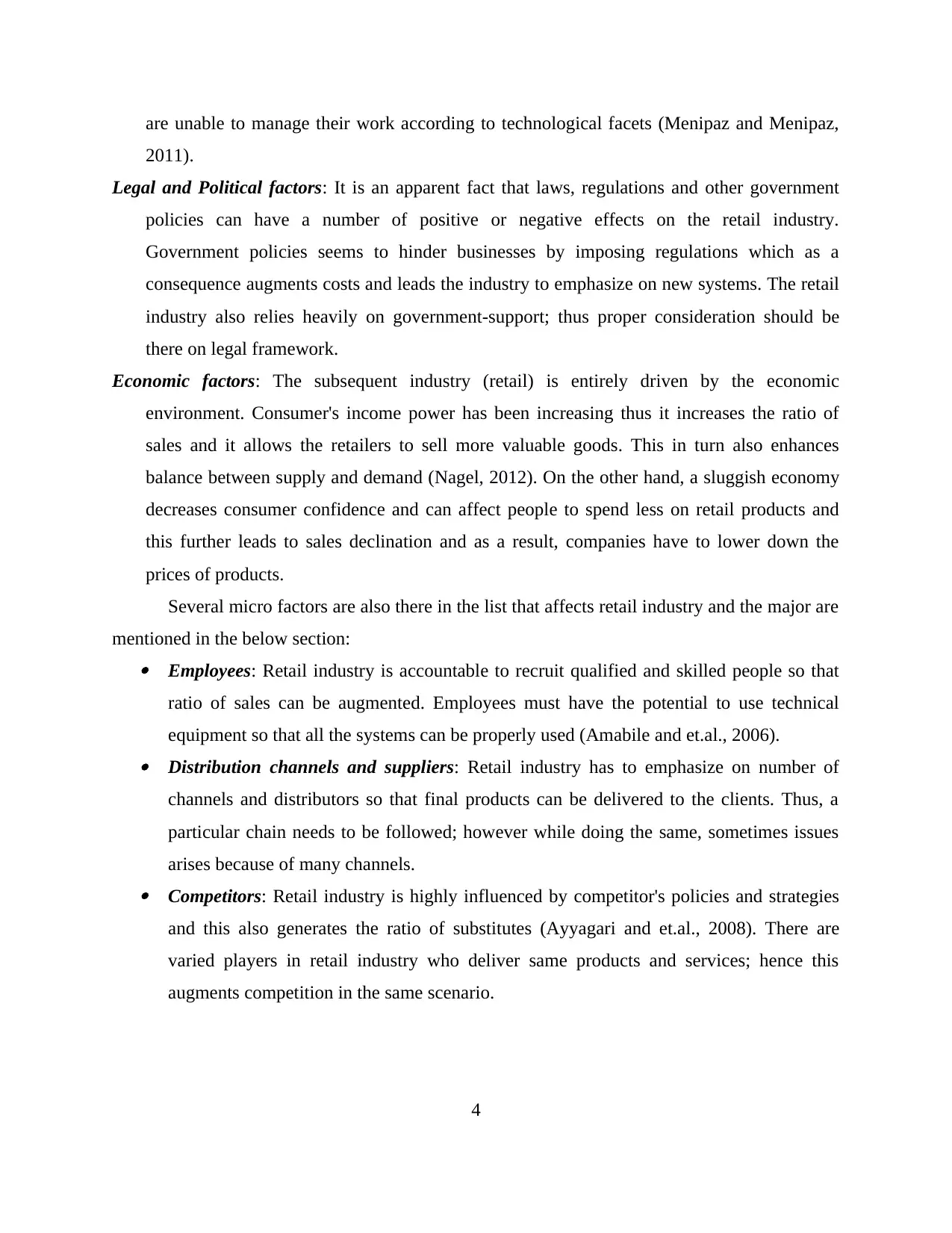
are unable to manage their work according to technological facets (Menipaz and Menipaz,
2011).
Legal and Political factors: It is an apparent fact that laws, regulations and other government
policies can have a number of positive or negative effects on the retail industry.
Government policies seems to hinder businesses by imposing regulations which as a
consequence augments costs and leads the industry to emphasize on new systems. The retail
industry also relies heavily on government-support; thus proper consideration should be
there on legal framework.
Economic factors: The subsequent industry (retail) is entirely driven by the economic
environment. Consumer's income power has been increasing thus it increases the ratio of
sales and it allows the retailers to sell more valuable goods. This in turn also enhances
balance between supply and demand (Nagel, 2012). On the other hand, a sluggish economy
decreases consumer confidence and can affect people to spend less on retail products and
this further leads to sales declination and as a result, companies have to lower down the
prices of products.
Several micro factors are also there in the list that affects retail industry and the major are
mentioned in the below section: Employees: Retail industry is accountable to recruit qualified and skilled people so that
ratio of sales can be augmented. Employees must have the potential to use technical
equipment so that all the systems can be properly used (Amabile and et.al., 2006). Distribution channels and suppliers: Retail industry has to emphasize on number of
channels and distributors so that final products can be delivered to the clients. Thus, a
particular chain needs to be followed; however while doing the same, sometimes issues
arises because of many channels. Competitors: Retail industry is highly influenced by competitor's policies and strategies
and this also generates the ratio of substitutes (Ayyagari and et.al., 2008). There are
varied players in retail industry who deliver same products and services; hence this
augments competition in the same scenario.
4
2011).
Legal and Political factors: It is an apparent fact that laws, regulations and other government
policies can have a number of positive or negative effects on the retail industry.
Government policies seems to hinder businesses by imposing regulations which as a
consequence augments costs and leads the industry to emphasize on new systems. The retail
industry also relies heavily on government-support; thus proper consideration should be
there on legal framework.
Economic factors: The subsequent industry (retail) is entirely driven by the economic
environment. Consumer's income power has been increasing thus it increases the ratio of
sales and it allows the retailers to sell more valuable goods. This in turn also enhances
balance between supply and demand (Nagel, 2012). On the other hand, a sluggish economy
decreases consumer confidence and can affect people to spend less on retail products and
this further leads to sales declination and as a result, companies have to lower down the
prices of products.
Several micro factors are also there in the list that affects retail industry and the major are
mentioned in the below section: Employees: Retail industry is accountable to recruit qualified and skilled people so that
ratio of sales can be augmented. Employees must have the potential to use technical
equipment so that all the systems can be properly used (Amabile and et.al., 2006). Distribution channels and suppliers: Retail industry has to emphasize on number of
channels and distributors so that final products can be delivered to the clients. Thus, a
particular chain needs to be followed; however while doing the same, sometimes issues
arises because of many channels. Competitors: Retail industry is highly influenced by competitor's policies and strategies
and this also generates the ratio of substitutes (Ayyagari and et.al., 2008). There are
varied players in retail industry who deliver same products and services; hence this
augments competition in the same scenario.
4
Paraphrase This Document
Need a fresh take? Get an instant paraphrase of this document with our AI Paraphraser
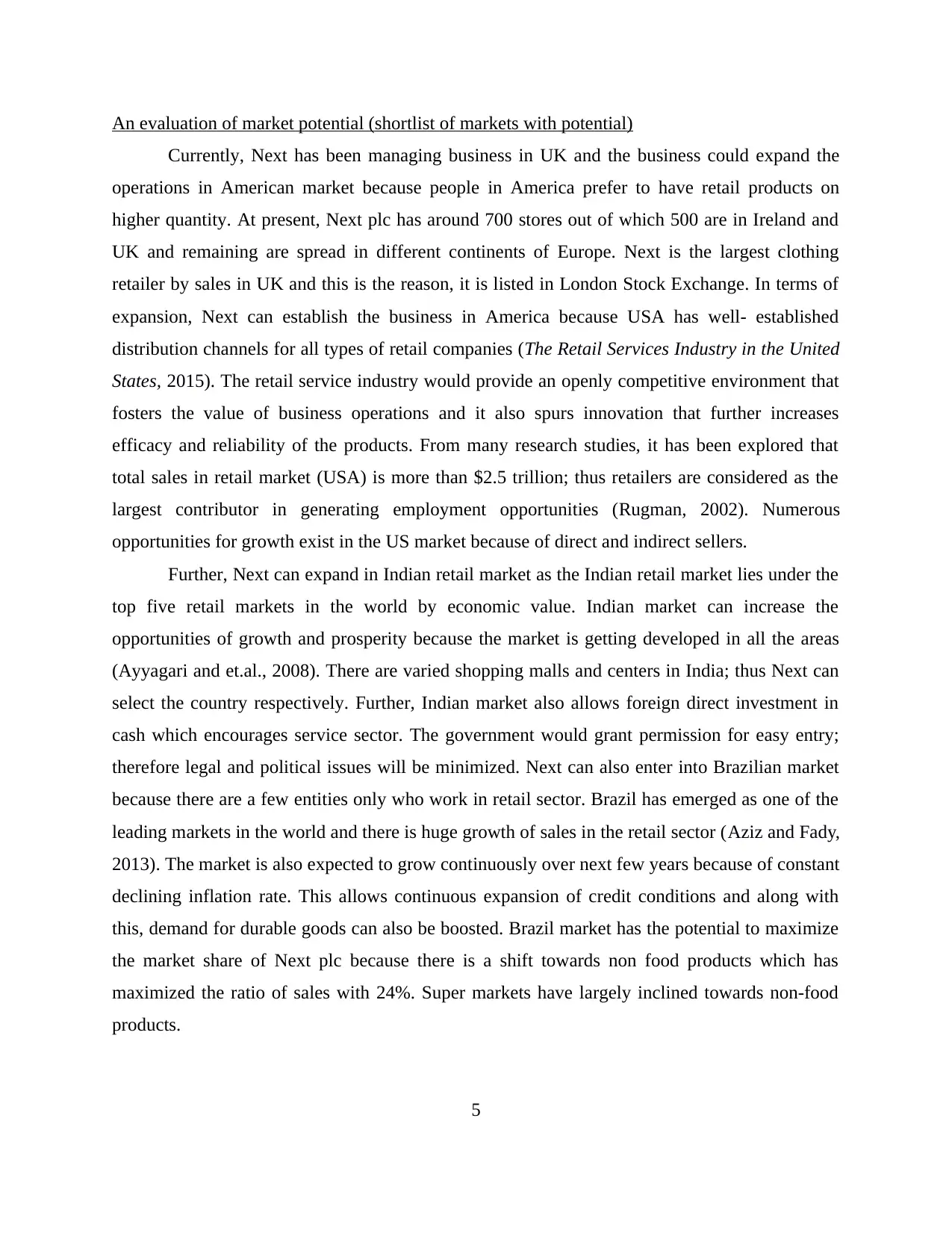
An evaluation of market potential (shortlist of markets with potential)
Currently, Next has been managing business in UK and the business could expand the
operations in American market because people in America prefer to have retail products on
higher quantity. At present, Next plc has around 700 stores out of which 500 are in Ireland and
UK and remaining are spread in different continents of Europe. Next is the largest clothing
retailer by sales in UK and this is the reason, it is listed in London Stock Exchange. In terms of
expansion, Next can establish the business in America because USA has well- established
distribution channels for all types of retail companies (The Retail Services Industry in the United
States, 2015). The retail service industry would provide an openly competitive environment that
fosters the value of business operations and it also spurs innovation that further increases
efficacy and reliability of the products. From many research studies, it has been explored that
total sales in retail market (USA) is more than $2.5 trillion; thus retailers are considered as the
largest contributor in generating employment opportunities (Rugman, 2002). Numerous
opportunities for growth exist in the US market because of direct and indirect sellers.
Further, Next can expand in Indian retail market as the Indian retail market lies under the
top five retail markets in the world by economic value. Indian market can increase the
opportunities of growth and prosperity because the market is getting developed in all the areas
(Ayyagari and et.al., 2008). There are varied shopping malls and centers in India; thus Next can
select the country respectively. Further, Indian market also allows foreign direct investment in
cash which encourages service sector. The government would grant permission for easy entry;
therefore legal and political issues will be minimized. Next can also enter into Brazilian market
because there are a few entities only who work in retail sector. Brazil has emerged as one of the
leading markets in the world and there is huge growth of sales in the retail sector (Aziz and Fady,
2013). The market is also expected to grow continuously over next few years because of constant
declining inflation rate. This allows continuous expansion of credit conditions and along with
this, demand for durable goods can also be boosted. Brazil market has the potential to maximize
the market share of Next plc because there is a shift towards non food products which has
maximized the ratio of sales with 24%. Super markets have largely inclined towards non-food
products.
5
Currently, Next has been managing business in UK and the business could expand the
operations in American market because people in America prefer to have retail products on
higher quantity. At present, Next plc has around 700 stores out of which 500 are in Ireland and
UK and remaining are spread in different continents of Europe. Next is the largest clothing
retailer by sales in UK and this is the reason, it is listed in London Stock Exchange. In terms of
expansion, Next can establish the business in America because USA has well- established
distribution channels for all types of retail companies (The Retail Services Industry in the United
States, 2015). The retail service industry would provide an openly competitive environment that
fosters the value of business operations and it also spurs innovation that further increases
efficacy and reliability of the products. From many research studies, it has been explored that
total sales in retail market (USA) is more than $2.5 trillion; thus retailers are considered as the
largest contributor in generating employment opportunities (Rugman, 2002). Numerous
opportunities for growth exist in the US market because of direct and indirect sellers.
Further, Next can expand in Indian retail market as the Indian retail market lies under the
top five retail markets in the world by economic value. Indian market can increase the
opportunities of growth and prosperity because the market is getting developed in all the areas
(Ayyagari and et.al., 2008). There are varied shopping malls and centers in India; thus Next can
select the country respectively. Further, Indian market also allows foreign direct investment in
cash which encourages service sector. The government would grant permission for easy entry;
therefore legal and political issues will be minimized. Next can also enter into Brazilian market
because there are a few entities only who work in retail sector. Brazil has emerged as one of the
leading markets in the world and there is huge growth of sales in the retail sector (Aziz and Fady,
2013). The market is also expected to grow continuously over next few years because of constant
declining inflation rate. This allows continuous expansion of credit conditions and along with
this, demand for durable goods can also be boosted. Brazil market has the potential to maximize
the market share of Next plc because there is a shift towards non food products which has
maximized the ratio of sales with 24%. Super markets have largely inclined towards non-food
products.
5
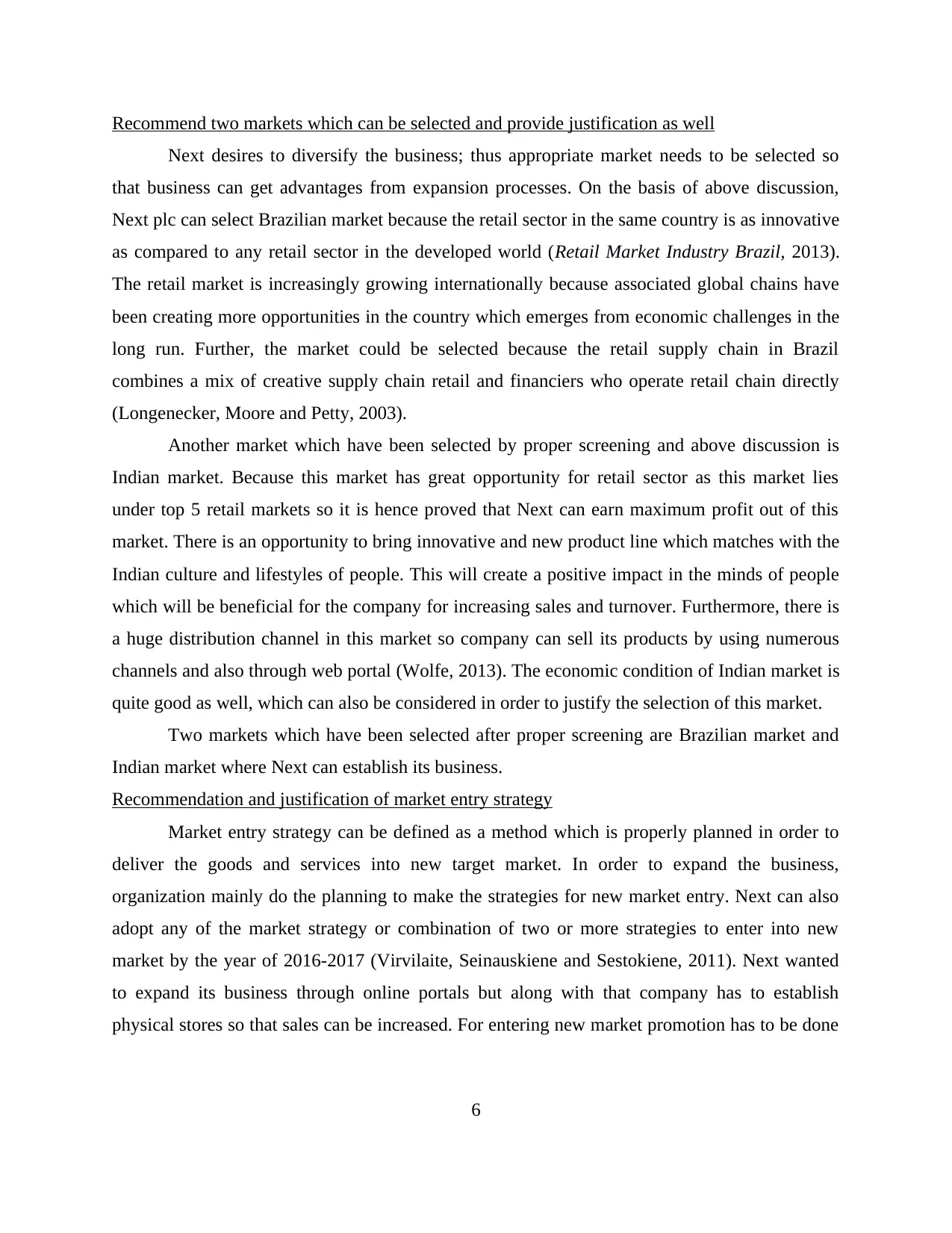
Recommend two markets which can be selected and provide justification as well
Next desires to diversify the business; thus appropriate market needs to be selected so
that business can get advantages from expansion processes. On the basis of above discussion,
Next plc can select Brazilian market because the retail sector in the same country is as innovative
as compared to any retail sector in the developed world (Retail Market Industry Brazil, 2013).
The retail market is increasingly growing internationally because associated global chains have
been creating more opportunities in the country which emerges from economic challenges in the
long run. Further, the market could be selected because the retail supply chain in Brazil
combines a mix of creative supply chain retail and financiers who operate retail chain directly
(Longenecker, Moore and Petty, 2003).
Another market which have been selected by proper screening and above discussion is
Indian market. Because this market has great opportunity for retail sector as this market lies
under top 5 retail markets so it is hence proved that Next can earn maximum profit out of this
market. There is an opportunity to bring innovative and new product line which matches with the
Indian culture and lifestyles of people. This will create a positive impact in the minds of people
which will be beneficial for the company for increasing sales and turnover. Furthermore, there is
a huge distribution channel in this market so company can sell its products by using numerous
channels and also through web portal (Wolfe, 2013). The economic condition of Indian market is
quite good as well, which can also be considered in order to justify the selection of this market.
Two markets which have been selected after proper screening are Brazilian market and
Indian market where Next can establish its business.
Recommendation and justification of market entry strategy
Market entry strategy can be defined as a method which is properly planned in order to
deliver the goods and services into new target market. In order to expand the business,
organization mainly do the planning to make the strategies for new market entry. Next can also
adopt any of the market strategy or combination of two or more strategies to enter into new
market by the year of 2016-2017 (Virvilaite, Seinauskiene and Sestokiene, 2011). Next wanted
to expand its business through online portals but along with that company has to establish
physical stores so that sales can be increased. For entering new market promotion has to be done
6
Next desires to diversify the business; thus appropriate market needs to be selected so
that business can get advantages from expansion processes. On the basis of above discussion,
Next plc can select Brazilian market because the retail sector in the same country is as innovative
as compared to any retail sector in the developed world (Retail Market Industry Brazil, 2013).
The retail market is increasingly growing internationally because associated global chains have
been creating more opportunities in the country which emerges from economic challenges in the
long run. Further, the market could be selected because the retail supply chain in Brazil
combines a mix of creative supply chain retail and financiers who operate retail chain directly
(Longenecker, Moore and Petty, 2003).
Another market which have been selected by proper screening and above discussion is
Indian market. Because this market has great opportunity for retail sector as this market lies
under top 5 retail markets so it is hence proved that Next can earn maximum profit out of this
market. There is an opportunity to bring innovative and new product line which matches with the
Indian culture and lifestyles of people. This will create a positive impact in the minds of people
which will be beneficial for the company for increasing sales and turnover. Furthermore, there is
a huge distribution channel in this market so company can sell its products by using numerous
channels and also through web portal (Wolfe, 2013). The economic condition of Indian market is
quite good as well, which can also be considered in order to justify the selection of this market.
Two markets which have been selected after proper screening are Brazilian market and
Indian market where Next can establish its business.
Recommendation and justification of market entry strategy
Market entry strategy can be defined as a method which is properly planned in order to
deliver the goods and services into new target market. In order to expand the business,
organization mainly do the planning to make the strategies for new market entry. Next can also
adopt any of the market strategy or combination of two or more strategies to enter into new
market by the year of 2016-2017 (Virvilaite, Seinauskiene and Sestokiene, 2011). Next wanted
to expand its business through online portals but along with that company has to establish
physical stores so that sales can be increased. For entering new market promotion has to be done
6
⊘ This is a preview!⊘
Do you want full access?
Subscribe today to unlock all pages.

Trusted by 1+ million students worldwide
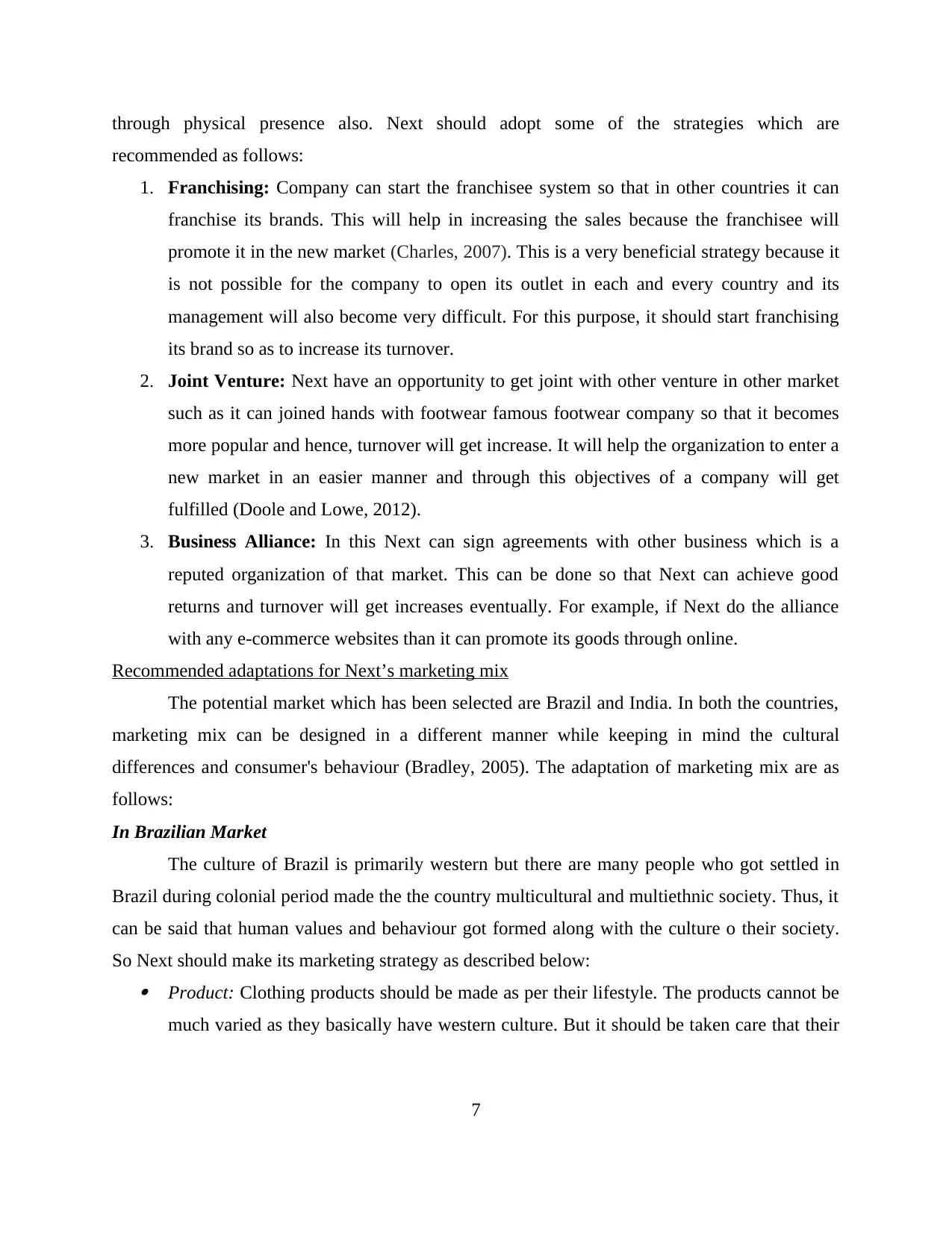
through physical presence also. Next should adopt some of the strategies which are
recommended as follows:
1. Franchising: Company can start the franchisee system so that in other countries it can
franchise its brands. This will help in increasing the sales because the franchisee will
promote it in the new market (Charles, 2007). This is a very beneficial strategy because it
is not possible for the company to open its outlet in each and every country and its
management will also become very difficult. For this purpose, it should start franchising
its brand so as to increase its turnover.
2. Joint Venture: Next have an opportunity to get joint with other venture in other market
such as it can joined hands with footwear famous footwear company so that it becomes
more popular and hence, turnover will get increase. It will help the organization to enter a
new market in an easier manner and through this objectives of a company will get
fulfilled (Doole and Lowe, 2012).
3. Business Alliance: In this Next can sign agreements with other business which is a
reputed organization of that market. This can be done so that Next can achieve good
returns and turnover will get increases eventually. For example, if Next do the alliance
with any e-commerce websites than it can promote its goods through online.
Recommended adaptations for Next’s marketing mix
The potential market which has been selected are Brazil and India. In both the countries,
marketing mix can be designed in a different manner while keeping in mind the cultural
differences and consumer's behaviour (Bradley, 2005). The adaptation of marketing mix are as
follows:
In Brazilian Market
The culture of Brazil is primarily western but there are many people who got settled in
Brazil during colonial period made the the country multicultural and multiethnic society. Thus, it
can be said that human values and behaviour got formed along with the culture o their society.
So Next should make its marketing strategy as described below: Product: Clothing products should be made as per their lifestyle. The products cannot be
much varied as they basically have western culture. But it should be taken care that their
7
recommended as follows:
1. Franchising: Company can start the franchisee system so that in other countries it can
franchise its brands. This will help in increasing the sales because the franchisee will
promote it in the new market (Charles, 2007). This is a very beneficial strategy because it
is not possible for the company to open its outlet in each and every country and its
management will also become very difficult. For this purpose, it should start franchising
its brand so as to increase its turnover.
2. Joint Venture: Next have an opportunity to get joint with other venture in other market
such as it can joined hands with footwear famous footwear company so that it becomes
more popular and hence, turnover will get increase. It will help the organization to enter a
new market in an easier manner and through this objectives of a company will get
fulfilled (Doole and Lowe, 2012).
3. Business Alliance: In this Next can sign agreements with other business which is a
reputed organization of that market. This can be done so that Next can achieve good
returns and turnover will get increases eventually. For example, if Next do the alliance
with any e-commerce websites than it can promote its goods through online.
Recommended adaptations for Next’s marketing mix
The potential market which has been selected are Brazil and India. In both the countries,
marketing mix can be designed in a different manner while keeping in mind the cultural
differences and consumer's behaviour (Bradley, 2005). The adaptation of marketing mix are as
follows:
In Brazilian Market
The culture of Brazil is primarily western but there are many people who got settled in
Brazil during colonial period made the the country multicultural and multiethnic society. Thus, it
can be said that human values and behaviour got formed along with the culture o their society.
So Next should make its marketing strategy as described below: Product: Clothing products should be made as per their lifestyle. The products cannot be
much varied as they basically have western culture. But it should be taken care that their
7
Paraphrase This Document
Need a fresh take? Get an instant paraphrase of this document with our AI Paraphraser
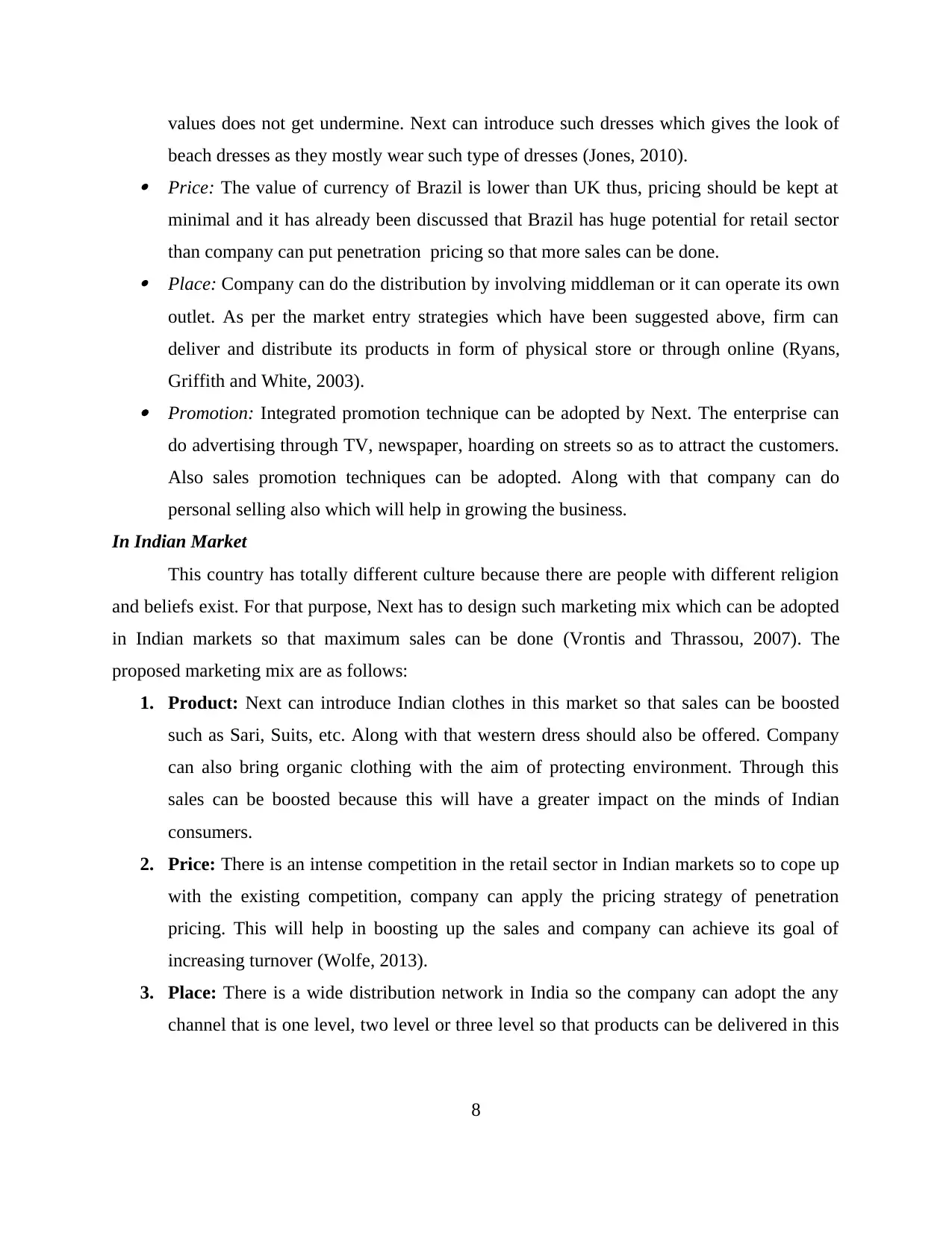
values does not get undermine. Next can introduce such dresses which gives the look of
beach dresses as they mostly wear such type of dresses (Jones, 2010). Price: The value of currency of Brazil is lower than UK thus, pricing should be kept at
minimal and it has already been discussed that Brazil has huge potential for retail sector
than company can put penetration pricing so that more sales can be done. Place: Company can do the distribution by involving middleman or it can operate its own
outlet. As per the market entry strategies which have been suggested above, firm can
deliver and distribute its products in form of physical store or through online (Ryans,
Griffith and White, 2003). Promotion: Integrated promotion technique can be adopted by Next. The enterprise can
do advertising through TV, newspaper, hoarding on streets so as to attract the customers.
Also sales promotion techniques can be adopted. Along with that company can do
personal selling also which will help in growing the business.
In Indian Market
This country has totally different culture because there are people with different religion
and beliefs exist. For that purpose, Next has to design such marketing mix which can be adopted
in Indian markets so that maximum sales can be done (Vrontis and Thrassou, 2007). The
proposed marketing mix are as follows:
1. Product: Next can introduce Indian clothes in this market so that sales can be boosted
such as Sari, Suits, etc. Along with that western dress should also be offered. Company
can also bring organic clothing with the aim of protecting environment. Through this
sales can be boosted because this will have a greater impact on the minds of Indian
consumers.
2. Price: There is an intense competition in the retail sector in Indian markets so to cope up
with the existing competition, company can apply the pricing strategy of penetration
pricing. This will help in boosting up the sales and company can achieve its goal of
increasing turnover (Wolfe, 2013).
3. Place: There is a wide distribution network in India so the company can adopt the any
channel that is one level, two level or three level so that products can be delivered in this
8
beach dresses as they mostly wear such type of dresses (Jones, 2010). Price: The value of currency of Brazil is lower than UK thus, pricing should be kept at
minimal and it has already been discussed that Brazil has huge potential for retail sector
than company can put penetration pricing so that more sales can be done. Place: Company can do the distribution by involving middleman or it can operate its own
outlet. As per the market entry strategies which have been suggested above, firm can
deliver and distribute its products in form of physical store or through online (Ryans,
Griffith and White, 2003). Promotion: Integrated promotion technique can be adopted by Next. The enterprise can
do advertising through TV, newspaper, hoarding on streets so as to attract the customers.
Also sales promotion techniques can be adopted. Along with that company can do
personal selling also which will help in growing the business.
In Indian Market
This country has totally different culture because there are people with different religion
and beliefs exist. For that purpose, Next has to design such marketing mix which can be adopted
in Indian markets so that maximum sales can be done (Vrontis and Thrassou, 2007). The
proposed marketing mix are as follows:
1. Product: Next can introduce Indian clothes in this market so that sales can be boosted
such as Sari, Suits, etc. Along with that western dress should also be offered. Company
can also bring organic clothing with the aim of protecting environment. Through this
sales can be boosted because this will have a greater impact on the minds of Indian
consumers.
2. Price: There is an intense competition in the retail sector in Indian markets so to cope up
with the existing competition, company can apply the pricing strategy of penetration
pricing. This will help in boosting up the sales and company can achieve its goal of
increasing turnover (Wolfe, 2013).
3. Place: There is a wide distribution network in India so the company can adopt the any
channel that is one level, two level or three level so that products can be delivered in this
8
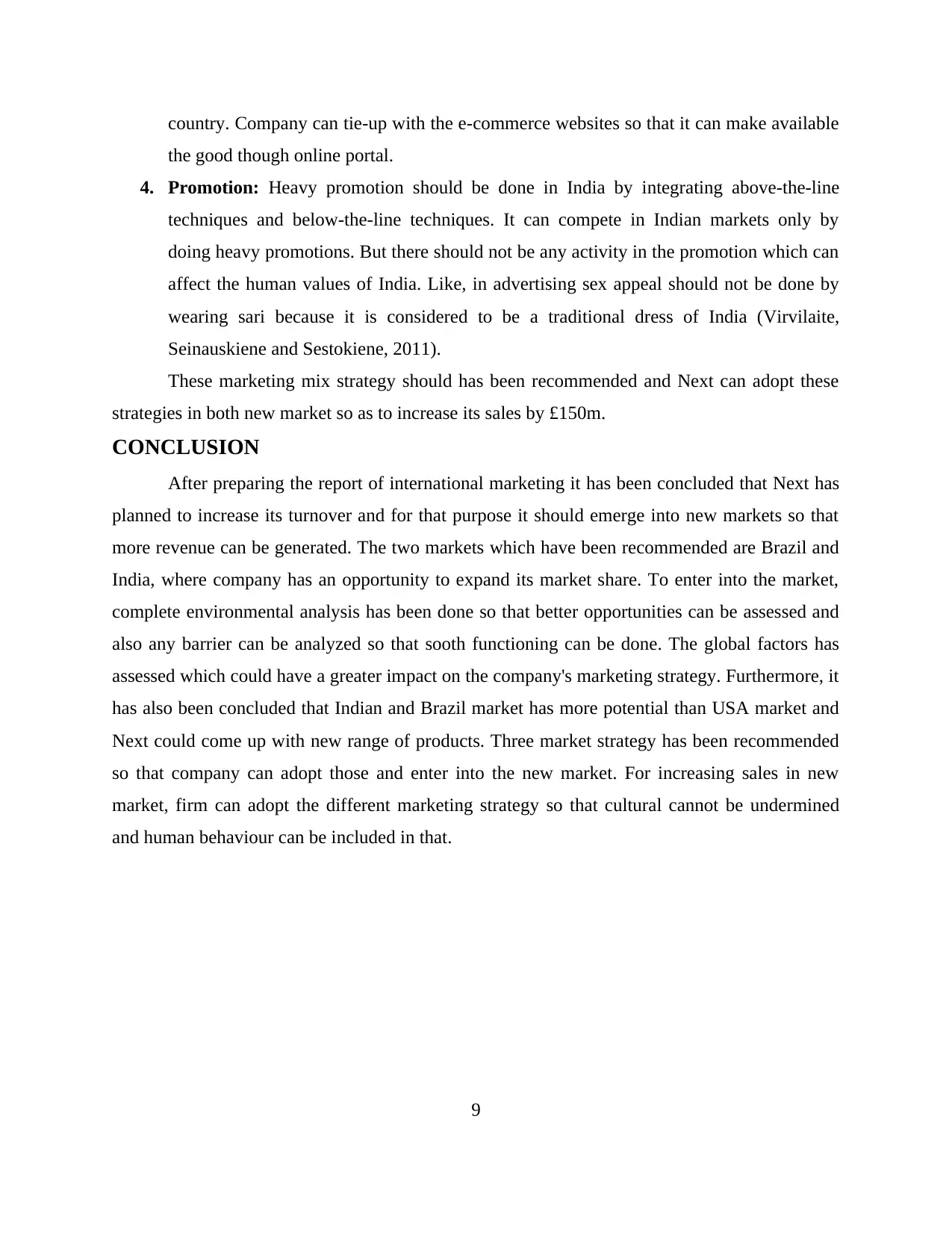
country. Company can tie-up with the e-commerce websites so that it can make available
the good though online portal.
4. Promotion: Heavy promotion should be done in India by integrating above-the-line
techniques and below-the-line techniques. It can compete in Indian markets only by
doing heavy promotions. But there should not be any activity in the promotion which can
affect the human values of India. Like, in advertising sex appeal should not be done by
wearing sari because it is considered to be a traditional dress of India (Virvilaite,
Seinauskiene and Sestokiene, 2011).
These marketing mix strategy should has been recommended and Next can adopt these
strategies in both new market so as to increase its sales by £150m.
CONCLUSION
After preparing the report of international marketing it has been concluded that Next has
planned to increase its turnover and for that purpose it should emerge into new markets so that
more revenue can be generated. The two markets which have been recommended are Brazil and
India, where company has an opportunity to expand its market share. To enter into the market,
complete environmental analysis has been done so that better opportunities can be assessed and
also any barrier can be analyzed so that sooth functioning can be done. The global factors has
assessed which could have a greater impact on the company's marketing strategy. Furthermore, it
has also been concluded that Indian and Brazil market has more potential than USA market and
Next could come up with new range of products. Three market strategy has been recommended
so that company can adopt those and enter into the new market. For increasing sales in new
market, firm can adopt the different marketing strategy so that cultural cannot be undermined
and human behaviour can be included in that.
9
the good though online portal.
4. Promotion: Heavy promotion should be done in India by integrating above-the-line
techniques and below-the-line techniques. It can compete in Indian markets only by
doing heavy promotions. But there should not be any activity in the promotion which can
affect the human values of India. Like, in advertising sex appeal should not be done by
wearing sari because it is considered to be a traditional dress of India (Virvilaite,
Seinauskiene and Sestokiene, 2011).
These marketing mix strategy should has been recommended and Next can adopt these
strategies in both new market so as to increase its sales by £150m.
CONCLUSION
After preparing the report of international marketing it has been concluded that Next has
planned to increase its turnover and for that purpose it should emerge into new markets so that
more revenue can be generated. The two markets which have been recommended are Brazil and
India, where company has an opportunity to expand its market share. To enter into the market,
complete environmental analysis has been done so that better opportunities can be assessed and
also any barrier can be analyzed so that sooth functioning can be done. The global factors has
assessed which could have a greater impact on the company's marketing strategy. Furthermore, it
has also been concluded that Indian and Brazil market has more potential than USA market and
Next could come up with new range of products. Three market strategy has been recommended
so that company can adopt those and enter into the new market. For increasing sales in new
market, firm can adopt the different marketing strategy so that cultural cannot be undermined
and human behaviour can be included in that.
9
⊘ This is a preview!⊘
Do you want full access?
Subscribe today to unlock all pages.

Trusted by 1+ million students worldwide
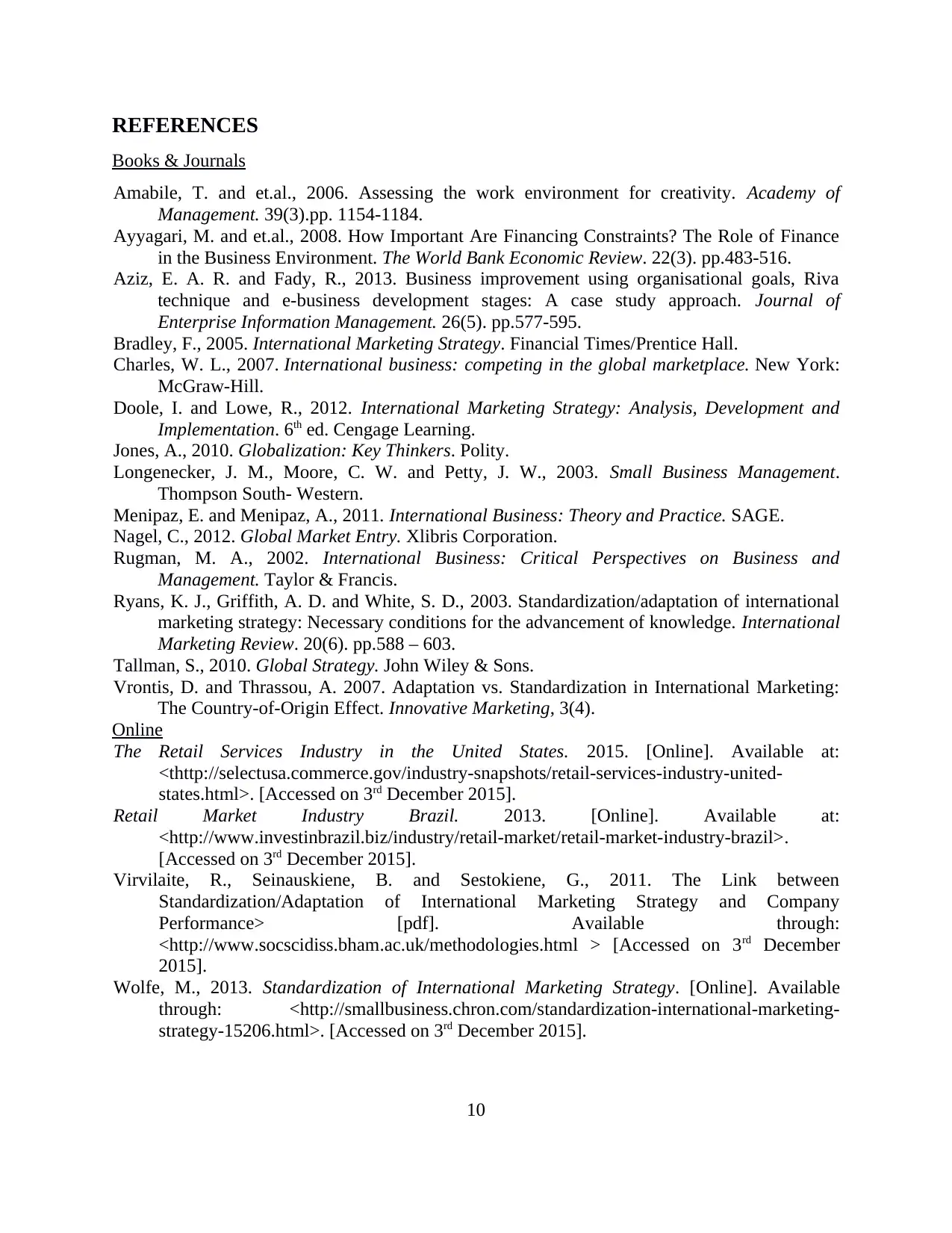
REFERENCES
Books & Journals
Amabile, T. and et.al., 2006. Assessing the work environment for creativity. Academy of
Management. 39(3).pp. 1154-1184.
Ayyagari, M. and et.al., 2008. How Important Are Financing Constraints? The Role of Finance
in the Business Environment. The World Bank Economic Review. 22(3). pp.483-516.
Aziz, E. A. R. and Fady, R., 2013. Business improvement using organisational goals, Riva
technique and e-business development stages: A case study approach. Journal of
Enterprise Information Management. 26(5). pp.577-595.
Bradley, F., 2005. International Marketing Strategy. Financial Times/Prentice Hall.
Charles, W. L., 2007. International business: competing in the global marketplace. New York:
McGraw-Hill.
Doole, I. and Lowe, R., 2012. International Marketing Strategy: Analysis, Development and
Implementation. 6th ed. Cengage Learning.
Jones, A., 2010. Globalization: Key Thinkers. Polity.
Longenecker, J. M., Moore, C. W. and Petty, J. W., 2003. Small Business Management.
Thompson South- Western.
Menipaz, E. and Menipaz, A., 2011. International Business: Theory and Practice. SAGE.
Nagel, C., 2012. Global Market Entry. Xlibris Corporation.
Rugman, M. A., 2002. International Business: Critical Perspectives on Business and
Management. Taylor & Francis.
Ryans, K. J., Griffith, A. D. and White, S. D., 2003. Standardization/adaptation of international
marketing strategy: Necessary conditions for the advancement of knowledge. International
Marketing Review. 20(6). pp.588 – 603.
Tallman, S., 2010. Global Strategy. John Wiley & Sons.
Vrontis, D. and Thrassou, A. 2007. Adaptation vs. Standardization in International Marketing:
The Country-of-Origin Effect. Innovative Marketing, 3(4).
Online
The Retail Services Industry in the United States. 2015. [Online]. Available at:
<thttp://selectusa.commerce.gov/industry-snapshots/retail-services-industry-united-
states.html>. [Accessed on 3rd December 2015].
Retail Market Industry Brazil. 2013. [Online]. Available at:
<http://www.investinbrazil.biz/industry/retail-market/retail-market-industry-brazil>.
[Accessed on 3rd December 2015].
Virvilaite, R., Seinauskiene, B. and Sestokiene, G., 2011. The Link between
Standardization/Adaptation of International Marketing Strategy and Company
Performance> [pdf]. Available through:
<http://www.socscidiss.bham.ac.uk/methodologies.html > [Accessed on 3rd December
2015].
Wolfe, M., 2013. Standardization of International Marketing Strategy. [Online]. Available
through: <http://smallbusiness.chron.com/standardization-international-marketing-
strategy-15206.html>. [Accessed on 3rd December 2015].
10
Books & Journals
Amabile, T. and et.al., 2006. Assessing the work environment for creativity. Academy of
Management. 39(3).pp. 1154-1184.
Ayyagari, M. and et.al., 2008. How Important Are Financing Constraints? The Role of Finance
in the Business Environment. The World Bank Economic Review. 22(3). pp.483-516.
Aziz, E. A. R. and Fady, R., 2013. Business improvement using organisational goals, Riva
technique and e-business development stages: A case study approach. Journal of
Enterprise Information Management. 26(5). pp.577-595.
Bradley, F., 2005. International Marketing Strategy. Financial Times/Prentice Hall.
Charles, W. L., 2007. International business: competing in the global marketplace. New York:
McGraw-Hill.
Doole, I. and Lowe, R., 2012. International Marketing Strategy: Analysis, Development and
Implementation. 6th ed. Cengage Learning.
Jones, A., 2010. Globalization: Key Thinkers. Polity.
Longenecker, J. M., Moore, C. W. and Petty, J. W., 2003. Small Business Management.
Thompson South- Western.
Menipaz, E. and Menipaz, A., 2011. International Business: Theory and Practice. SAGE.
Nagel, C., 2012. Global Market Entry. Xlibris Corporation.
Rugman, M. A., 2002. International Business: Critical Perspectives on Business and
Management. Taylor & Francis.
Ryans, K. J., Griffith, A. D. and White, S. D., 2003. Standardization/adaptation of international
marketing strategy: Necessary conditions for the advancement of knowledge. International
Marketing Review. 20(6). pp.588 – 603.
Tallman, S., 2010. Global Strategy. John Wiley & Sons.
Vrontis, D. and Thrassou, A. 2007. Adaptation vs. Standardization in International Marketing:
The Country-of-Origin Effect. Innovative Marketing, 3(4).
Online
The Retail Services Industry in the United States. 2015. [Online]. Available at:
<thttp://selectusa.commerce.gov/industry-snapshots/retail-services-industry-united-
states.html>. [Accessed on 3rd December 2015].
Retail Market Industry Brazil. 2013. [Online]. Available at:
<http://www.investinbrazil.biz/industry/retail-market/retail-market-industry-brazil>.
[Accessed on 3rd December 2015].
Virvilaite, R., Seinauskiene, B. and Sestokiene, G., 2011. The Link between
Standardization/Adaptation of International Marketing Strategy and Company
Performance> [pdf]. Available through:
<http://www.socscidiss.bham.ac.uk/methodologies.html > [Accessed on 3rd December
2015].
Wolfe, M., 2013. Standardization of International Marketing Strategy. [Online]. Available
through: <http://smallbusiness.chron.com/standardization-international-marketing-
strategy-15206.html>. [Accessed on 3rd December 2015].
10
1 out of 10
Related Documents
Your All-in-One AI-Powered Toolkit for Academic Success.
+13062052269
info@desklib.com
Available 24*7 on WhatsApp / Email
![[object Object]](/_next/static/media/star-bottom.7253800d.svg)
Unlock your academic potential
Copyright © 2020–2025 A2Z Services. All Rights Reserved. Developed and managed by ZUCOL.




